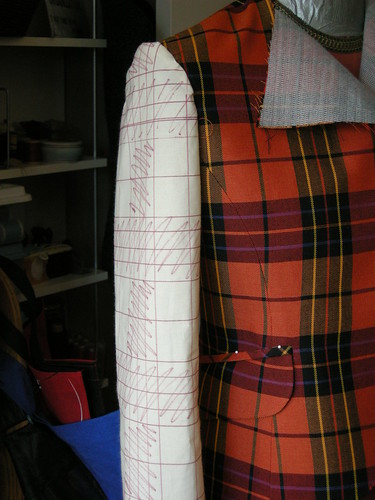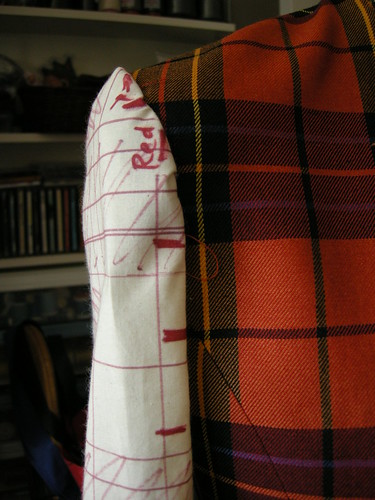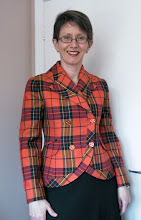I'm pleased to report that I have tamed the plaid at the sleeve ... phew! I did it by the most plodding approach possible. If any one of you reading this has a better and more elegant method I would love to hear about it. In the hopes of giving those of you who are better at this than I am a good laugh I will now illustrate my half-witted approach. In its defence, it did work...
Once I had the jacket body assembled I went back to my muslin sleeve (for once, my muslin was actually cut in plain muslin fabric) and took it apart. I went back to the traced sleeve pattern which, as you may recall from this post has plaid matching lines on it as supplied by Burda. Using the sleeve cap matching line I placed the muslin sleeve cap piece on the plaid fabric. With a Sharpie marker and a ruler, I drew the main elements of the plaid fabric right on the muslin. I then basted the muslin sleeve into the jacket body.
As you can see, the plaid decidedly does not match. Thankfully I was right not to quite trust those apparently-handy plaid-matching lines!
What to do? At first I thought I'd just measure the difference by which the sleeve needed to be shifted on the plaid. You can see that the plaid on the sleeve is consistently lower than the plaid on the jacket body - it was about 1.5cm (5/8") off. Then I thought it might be a bit tricky to transfer my knowledge onto the flat fabric for cutting - does the pattern piece need to be shifted up or down?? It is a bit confusing, that, even with this photo to remind me.
My solution was dead simple. Once again out came the Sharpie which I used to mark where the lines should be, right onto the muslin sleeve, like so.
I drew marks at the main horizontal elements, but also the vertical ones on the cap. I've tagged one of these lines "Red" so I would remember which part of the dark plaid box it was.
Once I had done that it was a simple matter to take the muslin sleeve out and transfer the knowledge I had gained through this exercise to the fabric.
The resulting sleeve, once set in, is pretty good, although not perfect at the vertical elements. I've read Kathleen Fasanella's posts on sleeve cap ease (she says it's bogus and uses a perfectly matched cap to illustrate - see part 1 and part 2). She says horizontal matching is impossible with sleeve cap ease, but I had no problem with the horizontal matching even though my sleeve pattern does have ease built in.
However, I'm still puzzling over how the tailors make a vertical line travel from the shoulder and directly down the front of the sleeve. In addition to the amazingly-matched sleeve cap in Kathleen's first sleeve cap ease post, check out the striped jacket in the first picture on this post from Made by Hand - the great Sartorial Debate - his right sleeve cap is flawless; the left one appears less so but I suspect this is only because of the angle of the photograph.
Maybe some day I will be able to manage this but for now, I have to settle with "good enough". Pictures will follow once I have the jacket a little further along.
Saturday, January 30, 2010
Subscribe to:
Post Comments (Atom)






One of my vintage garment making books, by Mabel Erwin? (it's not with me at the moment), says irregular plaids are impossible to work precisely and not to worry about it. The way you've worked out to match the horizontal is perfect, very nice, Kay.
ReplyDeleteI think your method is the same as Claire Shaeffer in one of her books if I remember correctly.
ReplyDeleteBrilliant approach, will remember this, thanks.
ReplyDeleteThe vertical line in the suit is not hard IF you don't have horizontal plaid as well, that's what makes it such a headache. But we never shy away from a challenge, do we :) I found wool plaid to be a lot more forgiving since you can steam shrink the cap, it's like cheating :))
So far so great, really great. I love the way the single dark line above the pocket welt apparently splits into two below it. It'll be a dynamite garment. And so many coordinating options, wow!
ReplyDeleteThat is a great idea. I imagine you have matched as well as perfect can be. Nice job!
ReplyDeleteBrava Kay ! That's how I learned to do it during my training. And as Birgitte points out, natural fibers like wool can be what I call "artfully manipulated" by steam :)
ReplyDeleteThank you for sharing your process. I'll have to try it the next time I work with plaid.
ReplyDeleteThe less plodding way of doing this is redrafting the sleeve to have no ease like they do in the industry since matching plaids in a sleeve with ease is not actually possible.
ReplyDeletehttp://fashion-incubator.com/archive/sleeve_cap_ease_is_bogus/
Well, since there is ease in this sleeve cap, and it does match, I respectfully have to disagree with your statement that "matching plaids in a sleeve with ease is not actually possible".
DeleteThanks! Really helpful. I'm just about to do the same thing for the sleeves of a tartan Grainline Scout woven tee.
ReplyDelete